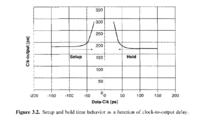Ramakrishna_444
Member level 2
Hey All,
How to plot the sampling window of the Flipflop..?
Is this graph mirror image about y-axis for Setup & Hold Time..? (Please follow the attachment)
What do I need to understand by the Positive & Negative Data to Clk Offset in the Graph...?
Follow the attachments for my concern......
Thanks in advance.......

How to plot the sampling window of the Flipflop..?
Is this graph mirror image about y-axis for Setup & Hold Time..? (Please follow the attachment)
What do I need to understand by the Positive & Negative Data to Clk Offset in the Graph...?
Follow the attachments for my concern......
Thanks in advance.......
